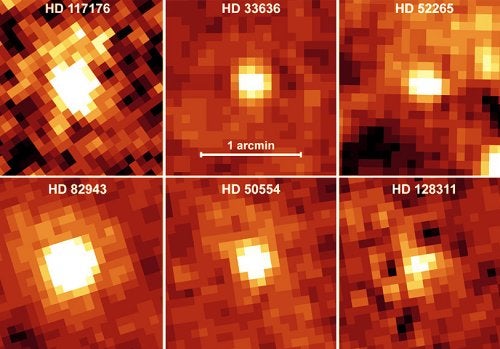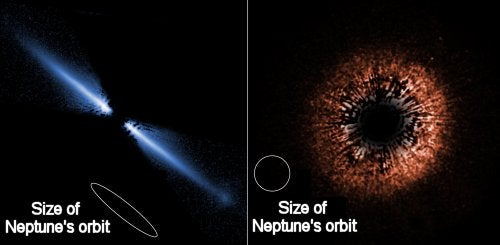In a phone-and-Internet news briefing yesterday, NASA scientists announced the Hubble Space Telescope and the Spitzer Space Telescope have produced fascinating and important images of dusty disks around Sun-like stars.
Alycia Weinberger, a staff research astronomer at the Carnegie Institution of Washington, says, “Prior to these observations, we didn’t know of any systems that harbored both planets and disks other than our own. The reason I’m excited about the Spitzer images is that they close the loop. They show us both the planets and the disk.”
David Ardila, a Hubble Space Telescope scientist from Johns Hopkins University, then shared two Hubble images that show debris disks around the stars AU Microscopii (AU Mic) and HD 107146. Both images were taken with Hubble’s Advanced Camera for Surveys using a coronagraph — a device that blocks the light from the star only.
The disk around AU Mic is approximately 4 times the size of our solar system. The image shows the dust particles (blue) miniscule, only about 1/20,000 millimeter in diameter — much smaller than household dust.
Each image shows a central hole similar in size to the orbit of Uranus around the Sun. Such a hole often forms when a planet (or planets) there clears out all the dust.
These findings confirm the part of planet-formation theory that allows rocky planets to form by collision early in a solar system’s history. The dust and debris seen in the Spitzer images were created as small planetary bodies crashed together. So, we’re not observing the creation of solar systems, but older ones like ours. Also, these systems are not likely to have earthlike planets because of the masses and locations of the planets that have been found already.
The newly discovered systems contain 10-100 times as much dust as the Kuiper Belt. “Still,” Beichman comments, “all the dust wouldn’t equal the mass of the Moon.”
“These systems will provide very exciting targets for future NASA missions,” says Weinberger. “The Terrestrial Planet Finder will certainly be able to see the disks and to resolve them and tell us about their structure.”












